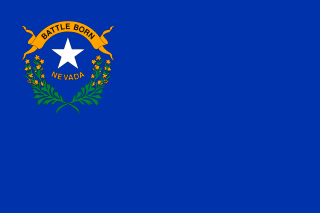
Lupinus sparsiflorus is a species of lupin native to North America. In the United States it occurs in California, Nevada, Arizona and Utah, and in Mexico it is found in Baja California and Sonora. Other common names include Mojave lupine, a name it shares with Lupinus odoratus.
Lupinus adsurgens is a species of lupine known by the common name Drew's silky lupine. It is native to the Sierra Nevada and coastal mountain ranges of northern California and southern Oregon, where it grows in forest and other mountain habitat. It is a perennial herb growing 20–60 centimetres (7.9–23.6 in) in height. Each palmate leaf is made up of 6 to 9 leaflets each up to 5 centimetres (2.0 in) long. The herbage is hairy and silvery or gray-green in color. The inflorescence is up to 23 centimetres (9.1 in) long, bearing flowers just over a centimeter long. The flower is pale pink or purple to yellowish with a white or yellow patch on the banner. The fruit is a silky-haired legume pod 2 to 4 centimetres (1.6 in) long containing 3 to 6 seeds.
Lupinus andersonii is a species of lupine known by the common name Anderson's lupine. It is native to California and adjacent sections of Oregon and Nevada, where it grows in dry mountain habitat of various types. This lupine is similar to Lupinus albicaulis in appearance. It is a hairy, erect perennial herb growing 20 to 90 centimeters in height. Each palmate leaf is made up of 6 to 9 leaflets each up to 6 centimeters long. The inflorescence is up to 23 centimeters long, bearing whorls of flowers each roughly a centimeter long. The flower is purple to yellowish or whitish in color. The fruit is a silky-hairy legume pod up to 4.5 centimeters long containing several seeds.

Lupinus angustiflorus is a species of lupine known by the common name narrowflower lupine. It is endemic to California, where it grows in the volcanic soils of the northeastern mountains and Modoc Plateau. It is an erect perennial herb sometimes exceeding one meter in height. Each palmate leaf is made up of 6 to 9 leaflets each up to 6 centimeters long. The inflorescence is up to 34 centimeters long, bearing many flowers each roughly a centimeter long. The flower is cream to pale yellow-orange with a patch of deeper yellow or orange on its banner. The keeled lower petals may be tipped with lavender. The fruit is a hairy legume pod up to 4 centimeters long.
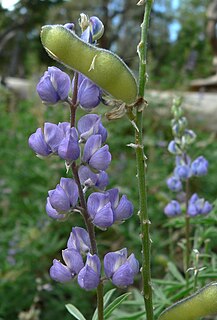
Lupinus argenteus is a species of lupine known by the common name silvery lupine. It is native to much of western North America from the southwestern Canadian provinces to the southwestern and midwestern United States, where it grows in several types of habitat, including sagebrush, grassland, and forests. This is a perennial herb growing erect to heights anywhere between 10 centimetres (3.9 in) and 1.5 metres (4.9 ft). It is sometimes silvery-hairy in texture and sometimes nearly hairless. Each palmate leaf is made up of 5 to 9 leaflets each up to 6 centimetres long. They are narrow and linear in shape, under a centimetre wide. The inflorescence bears many flowers, sometimes arranged in whorls. The flower is 5 millimetres (0.20 in) to 14 millimetres (0.55 in) long and purple, blue, or whitish in color. The banner, or upper petal, of the flower may have a patch of white or yellow. The fruit is a hairy legume pod up to 3 centimeters long containing several beanlike seeds.
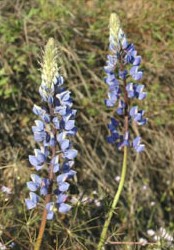
Lupinus benthamii is a species of lupine known by the common name spider lupine.
Lupinus brevicaulis is a species of lupine known by the common names shortstem lupine and sand lupine. It is native to the southwestern United States and Great Basin area and into northern Mexico, where it grows in many types of sandy habitat. This is a hairy annual herb growing nearly flat in a spread on the ground with a stem just a few centimeters long. An array of leaves encircles the base. Each palmate leaf is made up of 6 to 8 leaflets about a centimeter long and a few millimeters in width. The inflorescence is a petite spiral of flowers a few centimeters long just arising past the basal disc of leaves. Each flower is 6 to 8 millimeters long and bright blue in color, generally with a white or yellowish spot on its banner. The fruit is a hairy legume pod about a centimeter long containing 1 or 2 beanlike seeds.
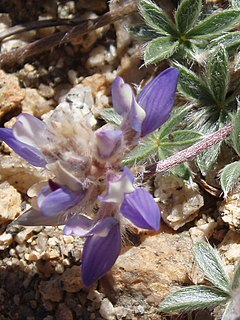
Lupinus breweri is a species of lupine known by the common names Brewer's lupine and matted lupine. It is native to much of California, except for the deserts, and to adjacent sections of Oregon and Nevada, where it is common in some areas, particularly mountain forests. Quite short for a lupine, this is a hairy, mat-forming perennial herb, sometimes becoming like a shrub, with a woody base. The leaves spread out from the stem. Each palmate leaf is made up of 5 to 10 woolly leaflets each up to 2 centimeters (0.79 in) long. The inflorescence is a dense raceme of flowers a few centimeters tall, each flower 4 to 11 millimeters. The flower is blue or purple with a white or yellowish spot on the banner. The fruit is a silky-hairy legume pod 1 or 2 millimeters long.
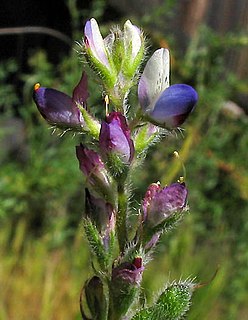
Lupinus concinnus is a species of lupine known by the common name Bajada lupine. It is native to the southwestern United States from California to Texas, and northern Mexico, where it is known from many types of habitat. This is a hairy erect or decumbent annual herb with a stem growing 10 to 30 centimeters long. Each small palmate leaf is made up of 5 to 9 leaflets up to 3 centimeters long and under a centimeter wide, sometimes narrow and linear in shape. The inflorescence is a dense spiral of flowers, with some flowers also appearing in leaf axils lower on the plant. Each flower is 5 to 12 millimeters long and purple, pink, or nearly white in color. The fruit is a hairy legume pod around a centimeter long.
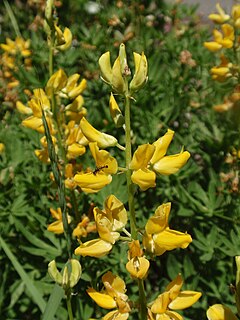
Lupinus croceus is a species of lupine known by the common name saffron-flowered lupine. It is endemic to the northernmost mountains of California, including the Klamath Mountains, where it grows in generally dry, rocky habitat. This is an erect perennial herb growing 40–60 centimetres (16–24 in) tall. The hairy palmate leaves are made up of 5 to 9 leaflets each up to 6 centimetres (2.4 in) long. The inflorescence is a raceme of many flowers, sometimes arranged in whorls. Each flower is just over a centimeter long and bright yellow to orange in color. The fruit is a hairy legume pod up to 3.5 centimetres (1.4 in) long.

Lupinus flavoculatus is a species of lupine known by the common name yelloweyes, or yellow-eyed lupine.,
Lupinus grayi is a species of lupine known by the common name Sierra lupine. It is endemic to California, where its distribution extends the length of the Sierra Nevada and its foothills and includes the Tehachapi Mountains.
Lupinus holmgrenianus is a species of lupine known by the common name Holmgren's lupine. It is native to the desert mountains of western Nevada and a few ranges of adjacent Inyo County, California, including the Last Chance Range of Death Valley National Park. This is a hairy perennial herb growing erect to a maximum height near 70 centimetres (28 in). Each palmate leaf is made up of 4 to 7 leaflets up to 5 centimetres (2.0 in) long. The inflorescence is a spiral of flowers each just over a centimeter long. They are purple in color with yellow patches on their banners. The fruit is a hairy legume pod 4 or 5 centimeters long.
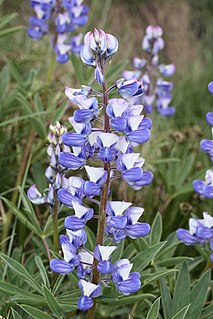
Lupinus latifolius is a species of lupine known by the common name broadleaf lupine. It is native to western North America from British Columbia to Baja California to New Mexico, where it is common and can be found in several types of habitat. There are several subtaxa, described as subspecies or varieties, some common and some rare. They vary in morphology. In general this plant is an erect perennial herb. It grows 30 centimeters to over two meters in height, in texture hairy to nearly hairless. Each palmate leaf is made up of several leaflets, those on larger plants up to 10 centimeters long. The inflorescence bears many flowers, sometimes in whorls. Each flower is one to two centimeters in length, purple to blue to white in color, the spot on its banner yellowish, pinkish, or white.
Lupinus luteolus is a species of lupine known by the common names pale yellow lupine and butter lupine. It is native to the coastal mountain ranges of Oregon and California as far south as the Transverse Ranges, where it grows in open habitat such as clearings and sometimes disturbed areas. It is an annual herb with a rigid stem growing to maximum heights anywhere between 30 centimeters and 1.5 meters, and known to exceed that at times. Each palmate leaf is made up of 7 to 9 hairy leaflets 1 to 3 centimeters long. The inflorescence is a raceme of crowded whorls of flowers each just over a centimeter long. The flower is often pale to bright yellow, but can be blue or pinkish. The fruit is a hairy, rounded or oval legume pod generally containing 2 seeds.
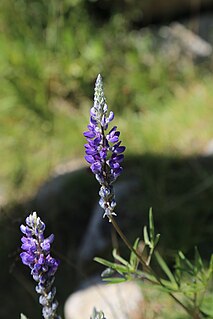
Lupinus pratensis is a species of lupine known by the common name Inyo meadow lupine. It is endemic to California, where it grows in the central Sierra Nevada and adjacent plateau and valleys to the east. It grows in relatively moist habitat, such as streambanks and spring meadows. This is an erect perennial herb growing 30–70 centimetres (12–28 in) tall. Each palmate leaf is made up of 5 to 10 narrow leaflets sometimes exceeding 10 centimetres (3.9 in) long. The leaves are borne on long petioles which can reach 25 centimetres (9.8 in) in length. The herbage is green and coated in thin hairs. The inflorescence is a dense raceme of many flowers each around a centimeter long. The flower is dark blue or purple with a reddish or orange patch on its banner. The fruit is a hairy legume pod around 2 centimetres (0.79 in) long.
Lupinus saxosus is a species of lupine known by the common name rock lupine. It is native to the Pacific Northwest and Great Basin of the United States, where it grows in sagebrush and other habitat. This is a perennial herb growing erect 20 to 30 centimeters tall. Each palmate leaf is made up of 7 to 13 hairy leaflets 1 to 4 centimeters long. The inflorescence is a dense raceme of many flowers sometimes arranged in whorls. The flower is between 1 and 2 centimeters long and blue in color with a yellowish or violet patch on its banner. The fruit is a shaggy-haired legume pod up to 4 centimeters in length.

Lupinus sericatus is a species of lupine known by the common name Cobb Mountain lupine. It is endemic to the North Coast Ranges of California north of the San Francisco Bay Area, where it grows in the forest, woodlands, and chaparral of the slopes and canyons. It easily colonizes disturbed habitat as well. This is a perennial herb growing up to half a meter tall. Each palmate leaf is made up of 4 to 7 distinctive wide spoon-shaped leaflets each 3 to 5 centimeters long. The inflorescence is a raceme of several whorls of purple flowers, each flower between 1 and 2 centimeters long. The fruit is a hairy legume pod 2 or 3 centimeters long.

Lupinus spectabilis is a species of lupine known by the common name shaggyhair lupine. It is endemic to a section of the central Sierra Nevada foothills in Mariposa and Tuolumne Counties, where it is a member of the serpentine soils flora.

Lupinus stiversii is a species of lupine known by the common names harlequin annual lupine and harlequin lupine. The plant was named for Army physician Dr. Charles Austin Stivers, who first collected it in 1862 near Yosemite.

